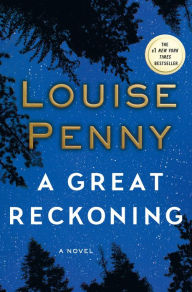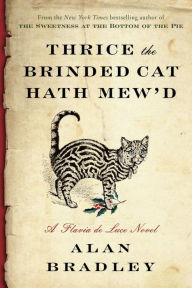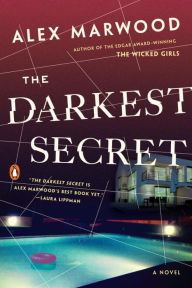 Cable TV shows — Motive, Murder in the First, Major Crimes — got me through the summer, and now it’s back to the books. A flurry of new crime novels last month soon turned into a bit of a blizzard. That’s fine — it’s still hot and steamy here in Florida, and I appreciate the chill of ice and snow, if only on the page.
Cable TV shows — Motive, Murder in the First, Major Crimes — got me through the summer, and now it’s back to the books. A flurry of new crime novels last month soon turned into a bit of a blizzard. That’s fine — it’s still hot and steamy here in Florida, and I appreciate the chill of ice and snow, if only on the page.
Winter is not just coming, it’s fast upon the Quebec village of Three Pines in Louise Penny’s A Great Reckoning (St. Martin’s Press, library hardcover). Former Chief Inspector Armand Gamache comes out of retirement to whip the national police academy into shape, searching for long-rooted corruption. An old map literally found in the walls of Three Pines figures into the expertly plotted puzzle, as does the murder of an authoritarian professor, Gamache’s interest in a fierce young cadet, and the almost forgotten lives of World War I soldiers. Loss shrouds the winter-haunted village, but also the possibility of forgiveness. This is my new favorite in the series, right up there with the piercing How the Light Gets In.
 Booted from boarding school in Canada, intrepid girl detective Flavia de Luce is delighted to be returning home to her crumbling English home Buckshaw in time for Christmas. But what should be a joyous homecoming in Alan Bradley’s clever Thrice the Brinded Cat Hath Mewed (Ballantine/Random House, digital galley) turns bleak when Flavia learns her beloved father, the Colonel, is in hospital with pneumonia. Unable to be at his bedside, Flavia tears off on an errand aboard her trusty bicycle Gladys and comes upon the body of a woodcarver hanging upside down from his bedroom door. “It’s amazing what the discovery of a corpse can do for one spirits,” thinks Flavia, seizing on the unusual clue of famous children’s books in the dead man’s possession. The curious cat also on the scene may be the companion of a rumored witch across the road, and that’s just beginning of a curious mystery in need of Flavia’s detecting skills.
Booted from boarding school in Canada, intrepid girl detective Flavia de Luce is delighted to be returning home to her crumbling English home Buckshaw in time for Christmas. But what should be a joyous homecoming in Alan Bradley’s clever Thrice the Brinded Cat Hath Mewed (Ballantine/Random House, digital galley) turns bleak when Flavia learns her beloved father, the Colonel, is in hospital with pneumonia. Unable to be at his bedside, Flavia tears off on an errand aboard her trusty bicycle Gladys and comes upon the body of a woodcarver hanging upside down from his bedroom door. “It’s amazing what the discovery of a corpse can do for one spirits,” thinks Flavia, seizing on the unusual clue of famous children’s books in the dead man’s possession. The curious cat also on the scene may be the companion of a rumored witch across the road, and that’s just beginning of a curious mystery in need of Flavia’s detecting skills.
 Julia Keller writes atmospheric mysteries set in the mountains of West Virginia, and Acker’s Gap, the hardscrabble hometown of prosecutor Bell Elkins, is practically a character in the series. Sorrow Road (St. Martin’s Minotaur, digital galley) is as chilly as its eye-catching cover, with several snowstorms impeding Bell’s investigation of a law school colleague’s death on an icy road, as well as her daughter Carla’s oral history project for the library. A nursing home where many of the residents have dementia ties several plot points together, including the murder of a staff member and the questionable deaths of several patients. Keller intersperses the present story with a past one about three local boys going off to fight World II and being together on D-Day.
Julia Keller writes atmospheric mysteries set in the mountains of West Virginia, and Acker’s Gap, the hardscrabble hometown of prosecutor Bell Elkins, is practically a character in the series. Sorrow Road (St. Martin’s Minotaur, digital galley) is as chilly as its eye-catching cover, with several snowstorms impeding Bell’s investigation of a law school colleague’s death on an icy road, as well as her daughter Carla’s oral history project for the library. A nursing home where many of the residents have dementia ties several plot points together, including the murder of a staff member and the questionable deaths of several patients. Keller intersperses the present story with a past one about three local boys going off to fight World II and being together on D-Day.
 I grew up in a Charlotte, N.C. subdivision very like fictional Sycamore Glen in Marybeth Mayhew Whalen’s The Things We Wish Were True (Lake Union, digital galley), and I can almost smell the chlorine at the neighborhood pool. It’s the social hub during sultry summer days, kids cannon-balling off the diving board, mothers trading suntan lotion and gossip, young teens hanging out. In Whalen’s story, told from multiple points-of-view, an accident at the pool disturbs the seemingly placid surface of Sycamore Glen, revealing secret undercurrents. It’s not a conventional mystery but rather a domestic/neighborhood drama with elements of suspense. Think Liane Moriarty (Truly Madly Guilty) or Lisa Jewell (The Girls in the Garden), only in an all-American small-town. Zell is the middle-aged empty nester who keeps an eye on the single dad next door and knows more than she’s letting on about his runaway wife. Jencey, hunted by a stalker in high school, returns 15 years later, her country-club life in ruins. Her former best friend Bryte is now happily married to Jencey’s high school boyfriend. Then there’s Cailey, the young girl who lives in a rental house, and the older single man across the street who takes care of his elderly mother. Whalen deftly weaves their lives together, and if some events are predictable, others surprise. Things are not what they seem in The Things We Wish Were True, the September selection of the She Reads online book club.
I grew up in a Charlotte, N.C. subdivision very like fictional Sycamore Glen in Marybeth Mayhew Whalen’s The Things We Wish Were True (Lake Union, digital galley), and I can almost smell the chlorine at the neighborhood pool. It’s the social hub during sultry summer days, kids cannon-balling off the diving board, mothers trading suntan lotion and gossip, young teens hanging out. In Whalen’s story, told from multiple points-of-view, an accident at the pool disturbs the seemingly placid surface of Sycamore Glen, revealing secret undercurrents. It’s not a conventional mystery but rather a domestic/neighborhood drama with elements of suspense. Think Liane Moriarty (Truly Madly Guilty) or Lisa Jewell (The Girls in the Garden), only in an all-American small-town. Zell is the middle-aged empty nester who keeps an eye on the single dad next door and knows more than she’s letting on about his runaway wife. Jencey, hunted by a stalker in high school, returns 15 years later, her country-club life in ruins. Her former best friend Bryte is now happily married to Jencey’s high school boyfriend. Then there’s Cailey, the young girl who lives in a rental house, and the older single man across the street who takes care of his elderly mother. Whalen deftly weaves their lives together, and if some events are predictable, others surprise. Things are not what they seem in The Things We Wish Were True, the September selection of the She Reads online book club.
 Be happy you weren’t invited to philandering land developer Sean Jackson’s 50th birthday party, which ended in disaster when Coco, one of his three-year-old twins, mysteriously vanished into the night, never to be seen again. This was in 2004, and now in the present day, Mila Jackson, 27, receives word of her estranged father’s scandalous death. All the houseguests at the ill-fated weekend will be at the funeral, except for her stepmother, Claire, who asks Mila to take teenage Ruby, the surviving twin. In The Darkest Secret (Penguin, library paperback), Alex Marwood skillfully uses flashbacks to tease out and eventually reveal (perhaps) what actually happened to young Coco. So readers do wind up at the scene of the crime, so to speak, privy to the bickering between narcissistic Sean and insecure Claire, and where the self-involved adults plan how to keep the handful of kids quiet while they party into the wee hours. It’s not pretty, nor is the funeral gathering, where someone else ends up dead.
Be happy you weren’t invited to philandering land developer Sean Jackson’s 50th birthday party, which ended in disaster when Coco, one of his three-year-old twins, mysteriously vanished into the night, never to be seen again. This was in 2004, and now in the present day, Mila Jackson, 27, receives word of her estranged father’s scandalous death. All the houseguests at the ill-fated weekend will be at the funeral, except for her stepmother, Claire, who asks Mila to take teenage Ruby, the surviving twin. In The Darkest Secret (Penguin, library paperback), Alex Marwood skillfully uses flashbacks to tease out and eventually reveal (perhaps) what actually happened to young Coco. So readers do wind up at the scene of the crime, so to speak, privy to the bickering between narcissistic Sean and insecure Claire, and where the self-involved adults plan how to keep the handful of kids quiet while they party into the wee hours. It’s not pretty, nor is the funeral gathering, where someone else ends up dead.

















